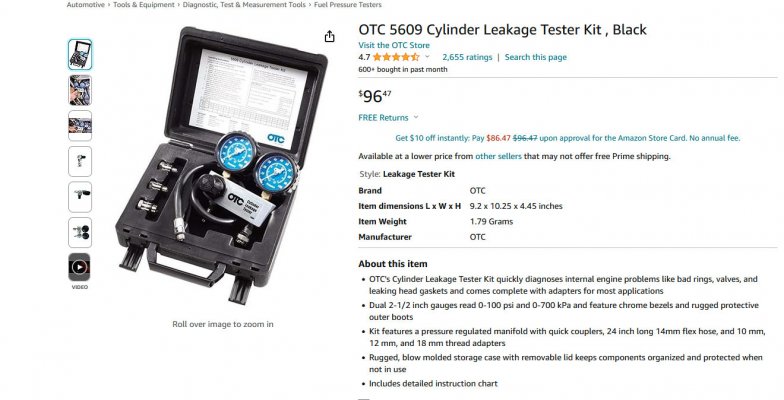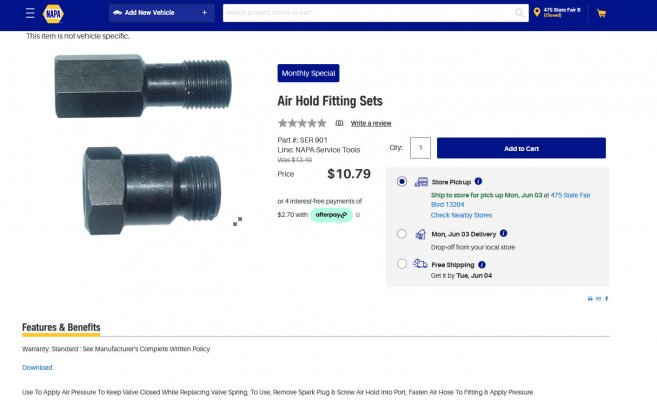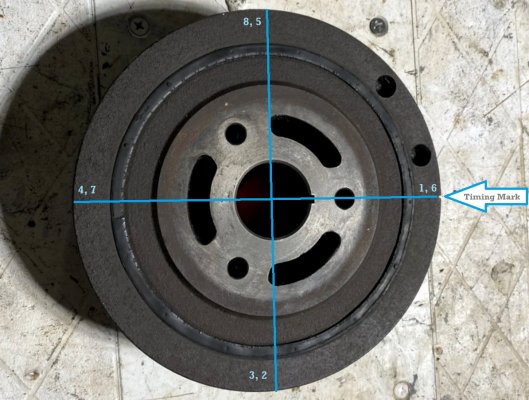I was thinking the same thing with the timing being off would cause all cylinders to have issues. Thank you for your input.Excellent! By this I mean that you are cross-checking your work *before* you
stuff the engine. Countless times I've been asked to troubleshoot a freshly installed
engine that isn't running right, and we find a showstopper that could have been easily
caught if the builder had only looked beforehand. And now the recovery effort is now 5x
more time & effort. :-(
I agree. Your symptoms don't match the 'wrong cam timing' scenario. Normally when there's
a timing issue *all* cylinders are delivering the wrong compression results in the same way.
What you are dealing with will be something incorrect in each 'bad' cylinder. One cylinder
could have an intake issue, one could be the exhaust, or some other failure combo. But
with focused testing you will get the data, and in turn we will follow that data to a successful
resolution.
I know that this can be frustrating, but at least you are verifying all this before the engine
comes off the stand, instead of just assuming that all is well and finding out post-installation
that there's a mechanical issue that won't go away until you take it back apart.
Please be sure to report back here with your findings. This way not only will we be able to
kick this around & sort it out, but it will help others who are doing their research prior to
building their own engines. Everyone walks away better for the shared experience. :0)
Best of luck --
You are using an out of date browser. It may not display this or other websites correctly.
You should upgrade or use an alternative browser.
You should upgrade or use an alternative browser.
No compression
- Thread starter katwood16
- Start date
Disclaimer: Links on this page pointing to Amazon, eBay and other sites may include affiliate code. If you click them and make a purchase, we may earn a small commission.
Update I have not gotten my compression tester yet but I removed the plugs in the good cylinders and put a plug in 1 and 8 and spun it while I listened to the intake and exhaust and I can hear air coming through the intake on the compression stroke.
Update I have not gotten my compression tester yet but I removed the plugs in the good cylinders and put a plug in 1 and 8 and spun it while I listened to the intake and exhaust and I can hear air coming through the intake on the compression stroke.
Troubleshooting a new build vs an engine that's been running a long time requires slightly
different rules/odds. For example, since computers instituted rev-limiters the number of
misfires traced back to excess-rpm valve float > bent intake valves is pretty rare.
On the other hand, if a new engine with known-good parts goes together, but the assembler
accidentally bottoms out a couple of lifters during the preload adjustment (and thereby hanging
the intake valve open even when it should be closed) it's possible to bend that intake valve
when said valve and piston fail to timeshare the same space correctly. (No doubt several folks
reading this have had this happen while they were on the engine building learning curve.)
The other scenario that comes to mind is that the valve adjustment was performed correctly,
but the machine shop got something wrong during the rebuild, and 2 of the valves aren't
seating properly. (This is rare, but I include this only because it *is* a possibility.)
Looking forward to your confirmation with the compression test numbers, followed by
the leakdown test confirming your hypothesis. It sux to have a setback like this, but
the silver lining in this cloud is that it will all make perfect sense after the fact. And
you will have learned 'hard-won' info that few of your contemporaries will ever know.
Last edited:
See I know that I I had the valves too tight initially when I went to install the distributor, but last night I took a bore scope to the plug hole. I couldn't see any evidence of valves hitting pistons. No marks or scratches on either piston or any valves
Also do the valve need to be set before performing a compression test as to allow the engine to draw air?Troubleshooting a new build vs an engine that's been running a long time requires slightly
different rules/odds. For example, since computers instituted rev-limiters the number of
misfires traced back to excess-rpm valve float > bent intake valves is pretty rare.
On the other hand, if a new engine with known-good parts goes together, but the assembler
accidentally bottoms out a couple of lifters during the preload adjustment (and thereby hanging
the intake valve open even when it should be closed) it's possible to bend that intake valve
when said valve and piston fail to timeshare the same space correctly. (No doubt several folks
reading this have had this happen while they were on the engine building learning curve.)
The other scenario that comes to mind is that the valve adjustment was performed correctly,
but the machine shop got something wrong during the rebuild, and 2 of the valves aren't
seating properly. (This is rare, but I include this only because it *is* a possibility.)
Looking forward to your confirmation with the compression test numbers, followed by
the leakdown test confirming your hypothesis. It sux to have a setback like this, but
the silver lining in this cloud is that it will all make perfect sense after the fact. And
you will have learned 'hard-won' info that few of your contemporaries will ever know.
No I am not this will be my first leak down test.Total compression or differential Leakdown? With all the plugs removed and total compression gauge you should be able to spin by hand and tool.
Are familiar with differential Leakdown testing?
If you watch a couple of videos it will all make sense. A stable air source in , then what is indicated the cylinder holds. That gives a percentage of pressure loss. And as stated earlier exhaust noise - exhaust valve. Intake or Throttle body - intake valve. Oil fill cap crankcase - ring/ cylinder problem .
Watching how it's done makes it all come together.
Watching how it's done makes it all come together.

No I am not this will be my first leak down test.
Most mechanics have performed a compression test, and following that start replacing big chunks
of real estate. And when asked if they have ever performed a leakdown test, some will act like
you are discussing going from simple addition straight to calculus?
That's not true at all. Those who want to know exactly where to pinpoint the problem (so that
they can retest after the repair and have true confidence in the fix) will routinely run a leakdown
test, partially to cross-check the results of the compression test, and again for the increased
diagnostic resolution.
It's easy to do. For our V8 engines:
1) Pull all 8 spark plugs. (I'll assume they are already out due to the compression test.)
2) Mark the harmonic balancer every 90°.
3) Rotate the engine to #1 TDC on the compression stroke, and apply compressed air via the spark plug
opening. Listen carefully at the throttle body, exhaust tip, and oil fill opening. Write down the results for
this cylinder.
4) Repeat step #3 (7) more times, until you have the results for all 8 cylinders.
5) Post the results of both the compression test & the leakdown test so that
we can roll around in the data and figure out what the engine (via your testing) is telling us.
HINT: You really want to get each piston as close to TDC as possible, for only when the connecting
rod is straight up and down will the piston stay in place. If you are off a few degrees, the 100 psi
x the surface area of the piston can move the crank a full 180° in a flash. And DON'T leave the
ratchet/socket combo on the crank bolt while you are testing, for it can fling that bad boy across the shop
if the crank moves...ask me how I know this. :0)
NOTE: Race teams can & will justify having a leakdown tester gauge (some even insisting on a
specific diameter orifice) in order to quantify exactly how much the ring seal has changed from race to
race. (And of course verify the valve/seat sealing too.) The lower the leakage rate the more the
tendency of these folks to post them. (Usually in % -- for example, you apply 100 psi and see that
on the 1st gauge, and the 2nd gauge shows '92', so they would refer to this as 8% leakage. See attached.)
****
But we aren't a race team trying to track the piston ring seal over time. Instead, we just want to
know if the intake valve, exhaust valve, or rings are where we need to focus in order to make this
bad cylinder good again. So all we need is compressed air fittings specifically designed to apply air
to a cylinder via the spark plug holes. (See 2nd attachment.)
Back in the day compression testing was a common skillset, even amongst the shade tree
mechanic community. But leakdown testing was pretty exotic for most automotive mechanics, but
was more common in the piston-engine aircraft community.
But now you know as much as I do about all this. It may take a try or two in order to get the hang
of it, but once you add this skill to your repertoire this will become an unfair advantage during any
future troubleshooting session that starts to delve into the mechanical health of the powerplant.
So there you have it. Compression test results for all 8 cylinders. Then take the NAPA compressed
air adapter, apply that to each cylinder in the firing order, further refine your diagnosis, and then
share the wealth with the forum.
I don't mind a problem, but I hate a mystery. Our goal is to have incontrovertible proof of what exactly
needs to happen in order to get all 8 cylinders to act exactly the same on your new build.
I am looking forward to your next status update.
Best of luck --
Attachments
-
 OTC 5609 Cylinder Leakage Tester Kit , Black Automotive.jpg191.9 KB · Views: 20
OTC 5609 Cylinder Leakage Tester Kit , Black Automotive.jpg191.9 KB · Views: 20 -
 Leakdown Test & valve seal Air Hold Fitting Sets SER 901 Buy Online - NAPA Auto Parts.jpg151.8 KB · Views: 19
Leakdown Test & valve seal Air Hold Fitting Sets SER 901 Buy Online - NAPA Auto Parts.jpg151.8 KB · Views: 19 -
 Harmonic Balancer ( marked -opt) Vortec 7.4L 454 Fits 96-00 CHEVROLET 2500 PICKUP eBay.jpg292.6 KB · Views: 5
Harmonic Balancer ( marked -opt) Vortec 7.4L 454 Fits 96-00 CHEVROLET 2500 PICKUP eBay.jpg292.6 KB · Views: 5
Last edited:
Similar threads
- Replies
- 18
- Views
- 780
- Replies
- 12
- Views
- 400
- Replies
- 3
- Views
- 271
Members online
- joes1992silverado
- Obslow
- Supercharged111
- loganf05
- WMT1990K150057
- dzynda
- BigJake03
- 0xDEADBEEF
- termite
- 454cid
- kingbozo1
- kxvobs
- Dropped88
- slow_c1500
- Cmiller
- abaker12
- Caman96
- nickbdavis21
- IndexOf0
- Drunkcanuk
- rebelyell
- mabco01
- Club_Sierra
- mudjeeper
- Clammer
- El Tigre
- Jp98c1500
- JDGMC
- Lextech
- rgb66
- dotwell69
- Charlesteneows
- HotWheelsBurban
- texasil
- Maxlaf226
- JohnZ71
- 64294501
- Alteca
- obsgod
- bigshane
- Leeztruk
- jakemoore
- sacredaverage
- JPVortex
- Ando069
- SierraK2500
- 1CanGMT400
- lght1
- ODaily
- mehcs
Total: 1,224 (members: 76, guests: 1,148)

